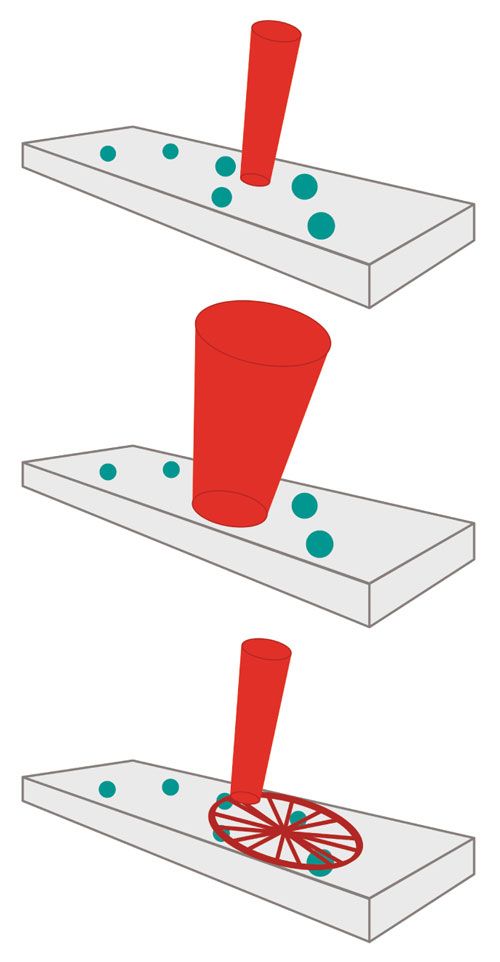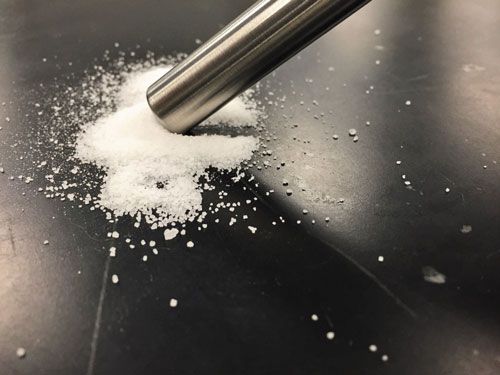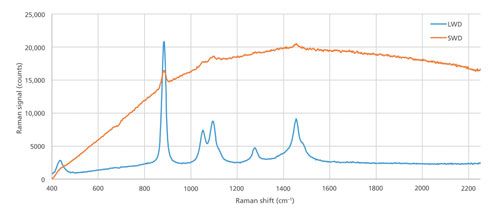Overcoming Struggles in Implementing Handheld Raman Spectroscopy Across the Manufacturing Line
Spectroscopy
Industry leaders answer this question: In what area will spectroscopy see the biggest growth in the next five years?
Raman spectroscopy has proven to be a useful tool in the manufacturing process because it can identify and verify samples without sample preparation. Measuring samples at the point of entry or point of use in the production process saves valuable time and eliminates the potential errors associated with transporting materials to the analytical laboratory. Despite these advantages, implementation of handheld Raman remains a challenge because the expectations of operators, method developers, and management are different. Fulfilling the expectations of these three important groups is key to successful implementation of handheld Raman across a process. This article sheds light on recent advances in sampling and instrument management that address the concerns and eliminate former barriers associated with the successful use of handheld Raman instruments.
Laboratory-based spectroscopy techniques, whether Fourier transform infrared (FT-IR), Raman, or another technology, require the same traditional workflow of sampling, labeling, and transporting the sample to the analytical lab. Traditional laboratory-based Raman instruments are expensive and primarily used for research and development by spectroscopists. Handheld and portable Raman systems bring this analytical capability into mainstream activities. Implementing handheld Raman can significantly streamline quality control measurements by eliminating this traditional workflow and measuring in situ.
Since the introduction of the first widely successful handheld Raman spectrometer, different sectors of the pharmaceutical and chemical industries have moved to adopt handheld Raman as a screening tool to replace traditional laboratory-based analysis methods. Handheld Raman instruments are now used as identification, verification, and screening tools across manufacturing lines for raw materials, in process samples, and finished products (Figure 1).
Figure 1: Examples of places where handheld Raman can be implemented in manufacturing.

Measurement traceability and cost-effectiveness are critical drivers of handheld Raman implementation across industries because of problems with poor quality raw materials, product adulteration, and counterfeit ingredients. In the pharmaceutical industry, traceability and incoming material inspection are mandated by United States Food and Drug Administration (FDA) regulations. Other sectors are following suit with the implementation of current good manufacturing practice (cGMP) and current good laboratory practice (cGLP) standards as a strategy to ensure quality.
Successful Handheld Raman Implementation
The disconnect between different stakeholders in implementing handheld Raman is a major reason for failed implementations of these instruments. The features and benefits that appeal to spectroscopists doing method development do not necessarily overlap with the end user on the production line or with upper management.
At the end-user level, there may be hundreds of incoming containers per day and the receiving facility may have thousands of materials. These operators likely have limited technical education, receive minimal training, and must maintain a high operational tempo. They expect an easy-to-use instrument. For method developers, a high level of technical expertise is a given. These stakeholders are concerned about compliance features, instrument specifications, error rates, and overall result reliability. At the management level other concerns need to be addressed, such as return on investment, instrument reliability, and the ease of deploying and managing multiple instruments.
Technology for Operators
The underlying technology for handheld Raman has advanced, resulting in systems that do more than verify raw materials and identify unknowns, but now identify multicomponent mixtures and can make quantitative measurements. Even fluorescence, long the bane of Raman spectroscopy at 785 nm, is being mitigated. The appearance of instruments with longer excitation wavelengths (above at 1000 nm) or multiple-wavelength excitation promises to extend handheld Raman’s reach into the analysis of increasingly difficult materials and matrices. Rapid through-package screening has become a reality with the recent advent of spatially offset Raman spectroscopy instruments. This instrumental development offers potential solutions to identifying and qualifying materials that should not be opened.
Despite these technological advances, fundamental challenges of user-to-user variation and material or packaging variety that are encountered when handheld Raman is used on the manufacturing floor remain. These challenges are mitigated by a combination of successful sampling strategies and continual end-user education. To address the challenges associated with sampling, instrument manufacturers are constantly improving the feature sets of their hardware and software to improve the data reliability while maintaining the usability that has made this family of tools successful.
A major challenge for operators can be variability of the Raman signals because of sample damage or material heterogeneity. Many organic materials and biopharmaceuticals degrade when exposed to 100+ mW laser beams with sub-millimeter diameters for 10–30 s. Because high laser powers are required to keep integration times short, there are two strategies for mitigation. One is to emit a large-diameter laser beam, which reduces the power density but requires larger collection optics for efficiency. A larger beam simultaneously compensates for material heterogeneity by measuring a macroscopic area. Another strategy is to raster the Raman laser beam across a small area of the sample at high speed (illustrated in Figure 2). This raster technology prevents the laser from being fixed on any area too long, avoiding damage. It also deals with heterogeneity by spatially averaging the sample. Because the spot size remains small, the size of the optical train can be reduced without sacrificing spectral resolution (1).
Figure 2: Orbital raster scan technology, in which a small diameter laser beam is rastered around a sample surface.

An additional challenge to implementation on the production floor is ease of use. The original handheld instruments were rather large and unwieldy. Many newer instruments are much smaller and lighter than the first- and second-generation handheld Raman spectrometers. They also feature additional improvements such as interchangeable batteries, touch-screen operation, and simpler user interfaces.
The first step to reliable Raman anywhere in the manufacturing line is selection of the correct sampling accessory. Standoff objective lenses, or point and shoot accessories, are the most commonly used sampling tools for handheld Raman. Rather than holding the sample at a specified distance from the instrument, these tools make direct contact with a container to provide a more consistent sample exposure. To use them correctly, simply press the objective against the surface of a bag or bottle and wait until the analysis is complete.
Because they come in a variety of focal lengths, it is important to choose the right lens for each application. Short working distance (SWD) objectives typically have focal lengths around 1 mm and are best used to scan through transparent and thin packaging, such as plastic bags and drum liners. Long working distance (LWD) accessories, sometimes called bottle adapters, have typical working distances of 5–10 mm and place the focal point, which is where the Raman signal is strongest, beyond the contact surface. This approach allows these accessories to measure inside transparent plastic and glass bottles without having to open them.
Standoff objectives, while flexible, occasionally provide unreliable or inconsistent results because of the operator’s inability to hold the sensor stable for the duration of the collection. This instability not only decreases the Raman signal, but also increases the amount of ambient light measured. Vial holders and tablet holders eliminate this challenge. Liquids or powders are transferred to disposable glass vials and inserted into a special holder that reproducibly positions the vial, avoiding operator error by providing stability to the measurement location. Tablet holders provide reproducible positioning of a tablet to the Raman sensor. Because of the wide variety of tablet shapes and sizes, reproducibly scanning tablets with a standoff objective is difficult; although necessary if the material cannot be removed from a blister pack. Some tablet holders require manual positioning and tightening of screws, making them more difficult to implement for high-throughput applications, but providing a high degree of operator control. Other instrument manufacturers provide spring-loaded holders that allow for quicker operation and reproducible placement.
The use of dedicated accessories requires more time than in situ measurement and incurs extra materials cost through both vial and analyte loss. Immersion probes eliminate these costs. By bringing the sample into direct contact with the probe, human error from mispositioning of the standoff objective is also eliminated. This ability to do in situ measurements with minimal sample handling provides a way to evaluate large numbers of samples very rapidly. Figure 3 shows an example of an immersion probe in use.
Figure 3: Detail of an immersion probe (MarqMetrix) with a solid sample.

The Raman probes for handheld instruments currently available have long stainless steel shafts with sapphire windows that can take direct measurements inside containers such as barrels, drums, and bottles. New probes now exist with an exposed sapphire sphere instead of a window, which gives a very short focal length of around 0.5 mm. This small depth of field makes this probe type well-suited for measuring solid samples and small amounts of materials on surfaces. Handheld Raman spectrometers with probes may also be directly inserted into the production line. For example, blend homogeneity can easily be monitored with Raman spectroscopy, and reaction monitoring has been shown to be a viable application for handheld instruments (2). Although process monitoring can also be accomplished with viewports and standoff objectives (3), immersion probes minimize the impact on the manufacturing line.
Technology for Method Developers
As a method developer, is it not sufficient to have a method that works in the laboratory alone. Both the algorithms and the operating procedures must be durable. Operator-driven errors must be minimized and instruments must function consistently. For example, some manufacturers have added coded memory chips to their sampling accessories so that their instruments know which accessory each measurement is collected by. These accessories can be locked to a particular method, preventing the use of an incorrect sampling tool and avoiding errors like the example shown in Figure 4. The sample accessory information is recorded in the instrument audit trail to provide additional measurement traceability.
Figure 4: Spectra collected from an ethanol bottle with LWD (blue) and SWD (orange) lenses with a Mira M-3 handheld Raman spectrometer (Metrohm).

Sample naming, which can require time-consuming entering of characters into a handheld via a small touch-screen or selecting through a direction pad, has been largely automated by instrument manufacturers. Batch scanning, in which the naming parameters are configured and then left alone on the instrument until the task is complete, is available in many instruments and significantly accelerates data collection and analysis. Many of the instruments available today also have integrated bar-code readers. These can be configured to automatically populate sample name, lot, and batch fields with information according to how they are configured in the software. Bar-code scanning and task automation ensure that accurate sample information is captured and signed, reducing post-analysis correction time.
Many industries use materials that do not exist in qualified libraries provided by instrument manufacturers. In these cases, open library structures allow developers to create qualified library elements for identification and to build verification methods that use many samples, capturing the variance of the acceptable raw materials. The robustness of these methods can be further enhanced by implementing additional controls on operating procedures. Older generation instruments were fully automatic, thereby preventing optimization of presumptive analysis methods, which could lead to sample degradation and poor quality data. This problem requires revalidation of the method and instrument for every chemical. Some of the new instruments on the market today have enhanced controls that can be programmed into the method such as measurement time, sample averaging, laser power, and even algorithm thresholds. These features can ensure that every analysis is performed exactly as it was in the laboratory, when qualified materials were used to develop the libraries and training sets to reduce the regulatory burden.
Implementing Handheld Raman Across Multiple Locations
There is currently no accepted standard method for developing and validating spectral libraries. Calibration survivability and automated method transferability between instruments vary among manufacturers, and there is no established baseline. Because of this lack of uniformity, each measurement should be independently validated on each instrument to ensure consistent results across sites. Operating procedure transfer can overcome this problem and reduce the amount of validation required because the operating procedure is validated according to United States Pharmacopeia (USP) Chapter <1224> (4). Higher levels of instrument performance available through operating procedure controls in newer instruments make it easier to deploy instruments across multiple sites.
Conclusion
Software and hardware innovations in sampling and instrument control are increasing the reliability of handheld Raman measurements, making the technology suited for a wider number of users and applications. High quality, simple sampling accessories optimized for different applications deliver rapid and reproducible results. Microchips, bar-code readers, and the seamless integration of hardware and software have enabled handheld Raman to be implemented by a variety of users for applications ranging from incoming materials inspection, to production monitoring, and finished product inspection.
References
- M. Watson, S. Buller, and K. Carron, U.S. Patent 8988678 B2. August 31, 2011.
- T. Padlo and K. Bakeev, Spectroscopy31(9), 16–22 (2016).
- A.J. Hopkins, “Implementation of Handheld Raman for Online and at Line Applications,” presented at IFPAC 2017, North Bethesda, Maryland, 2017.
- United States Pharmacopeia General Chapter <1224> “Transfer of Analytical Procedures” (United States Pharmacopeial Convention, Rockville, Maryland).
Adam J. Hopkins, PhD, is with Metrohm USA in Riverview, Florida. Direct correspondence to: ahopkins@metrohmusa.com

Portable and Wearable Spectrometers in Our Future
December 3rd 2024The following is a summary of selected articles published recently in Spectroscopy on the subject of handheld, portable, and wearable spectrometers representing a variety of analytical techniques and applications. Here we take a closer look at the ever shrinking world of spectroscopy devices and how they are used. As spectrometers progress from bulky lab instruments to compact, portable, and even wearable devices, the future of spectroscopy is transforming dramatically. These advancements enable real-time, on-site analysis across diverse industries, from healthcare to environmental monitoring. This summary article explores cutting-edge developments in miniaturized spectrometers and their expanding range of practical applications.
Q&A: Portable FT-IR Empowers On-Site Food Quality Assurance
February 1st 2024Exploring the transformative capabilities of handheld Fourier transform infrared (FT-IR) spectrometers, Luis Rodriguez-Saona of The Ohio State University emphasizes their pivotal role in ensuring food integrity and safety across the entire supply chain.
Portable Raman Spectrometers: How Small Can They Get?
June 1st 2023There is a growing desire among spectroscopists for having instruments small enough to be taken to the sample, as opposed to bringing the sample to the instrument. The result is that Raman spectrometers are becoming more miniaturized. Because these instruments come at a lower cost and offer distinct advantages over traditional spectrometers, the expectation is that a rapid expansion of when these instruments are applied will come forthwith. We offer a preview of how future miniaturized Raman spectrometers might look.